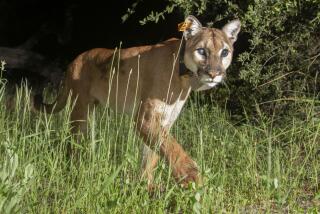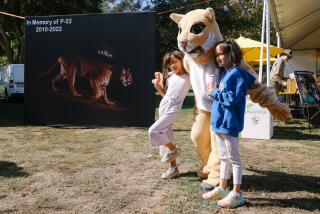Cougars and other creatures need an overpass to ease their commute
A couple of weeks ago, my wife and I drove up to the Griffith Observatory to take a look at Saturn through the big old telescope and to look down at the lights of Los Angeles spread across the basin below. On a sunset walk guided by a park ranger, we also got a glimpse of another side of L.A. — the wild side.
The ranger told us about a cougar named P-22 who resides in a remote corner of Griffith Park. He hasn’t bothered any of the thousands of Angelenos and tourists who visit the city’s big, legacy park day after day. The imposing cat is content feeding off the deer that roam the area. Content for now, that is. Soon, nature’s urgings will make the young cougar restless and eager to find a mate. With no females nearby, that means he will have to make a perilous journey.
There are not a lot of dangers for a mountain lion. They pretty much rule their habitat. But this cat’s current home is bounded by freeways on three sides. I’m not sure where an L.A. cougar goes to find a partner, but if it is north into the Angeles National Forest, he will have to traverse the 2, 5 and 210 freeways. If the love of his life is waiting to the west in the Santa Monica Mountains where P-22 was born, he will have to cross the 101 and the 405. (Heading south to Hollywood, he’d find the wrong kind of “cougar.”)
P-22 got his designation from the National Park Service. The service has put GPS tags on many of the local mountain lions to keep track of their wandering search for a range wide enough for them to avoid conflict with other cougars. The cats need to put a space of as much as 200 square miles between each other to feel comfortable, and that is not an easy task in a region where 18 million people with their cars, roads and housing developments are splitting up the landscape.
Another cougar, P-32, was killed last month as he made his own search for open territory. P-32 had made a long trek from the mountains above Malibu way up to Pyramid Lake in Los Padres National Forest. He crossed four highways to get there, including the very imposing 101 freeway, but, when he tried to run across Interstate 5 near Castaic Lake, he was hit by a car. P-32 was the 12th cougar killed by a vehicle in the L.A. area since 2002.
Obviously, the tangle of freeways that radiates in every direction in Southern California is a huge hazard for the wildlife that, amazingly, continues to hold on in this human-dominated world. Yet, in rural areas, too, roads prove fatal for all kinds of animals. Highway 212 between the Custer Battlefield National Monument in southeast Montana and Belle Fourche on the western edge of South Dakota is a notorious paved slaughterhouse littered by roadkill of all kinds.
Now, a few guilty attempts are being made to give animals a better chance of surviving in a country carved up by broad lanes jammed with speeding trucks and cars. East of Seattle near Snoqualmie Pass, the state of Washington has begun construction of an Interstate 90 overpass that is just for animals — any creature, from cougars and black bears to mice and lizards. Such critter crossings are common in Canada and parts of Europe and Africa.
Soon, there may be one such wildlife bridge spanning the 101 Freeway in Agoura Hills, west of L.A. If the state of California gives the go-ahead to the proposed overpass, animals will have an easier time making their commute between the Santa Monica Mountains to the south and the Simi Hills and Santa Susana Mountains to the north. That will be one freeway crossing down and many more to go.
It’s a small but hopeful step for the most aggressively dominant species on the planet — us humans — to return a tiny bit of ground to all of God’s other creatures.
More to Read
A cure for the common opinion
Get thought-provoking perspectives with our weekly newsletter.
You may occasionally receive promotional content from the Los Angeles Times.







